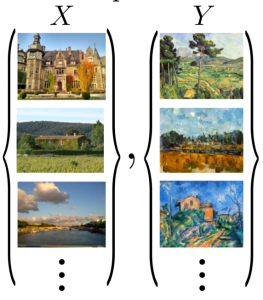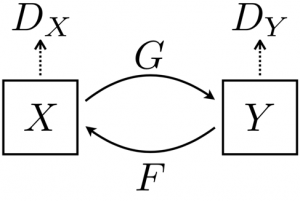What did Claude Monet see when he painted this picture?
 Source: Unpaired Image-to-Image Translation using Cycle-Consistent Adversarial Networks
Source: Unpaired Image-to-Image Translation using Cycle-Consistent Adversarial Networks
If color photography had been invented in 1873, we might have had a definitive answer to this question. But even without a color photograph, we know that it would probably show a clear blue sky and a river reflecting the sky.
The next question, of course, is what would Monet have painted if he had set up his easel in front of another landscape.
In their paper “Unpaired Image-to-Image Translation using Cycle-Consistent Adversarial Networks,” scientists from Berkeley AI Research have developed an algorithm that can answer this question with the help of AI. Their approach is similar to how we humans would approach the task. The easiest way would be to see a Monet painting next to a color photograph of the scene he was painting. Unfortunately, we don’t have this data.
Instead, we can look at Monet’s paintings and landscapes. If we then look at a landscape painting, we can more or less imagine what a Monet painting would look like if he had painted that scene. This process also works in the opposite direction. When we look at a Monet painting, we can imagine what a landscape of the same scene would look like.
This thought experiment can be formulated as follows:
As training data, we have a data set X with landscape pictures and a data set Y with paintings. For these training data, we are looking for a mapping of landscape images to paintings and back to landscape images.


Source: Unpaired Image-to-Image Translation using Cycle-Consistent Adversarial Networks
The neural network used to find this figure is called the Cycle-Consistent Adversarial Network.
Cycle-Consistent Adversarial Networks can not only turn landscape images into paintings by different painters but can also replace horses with zebras or change the seasons on images.

Source: Unpaired Image-to-Image Translation using Cycle-Consistent Adversarial Networks
If you would like to know how we can help you to add value to your images, please contact us at
Zurück